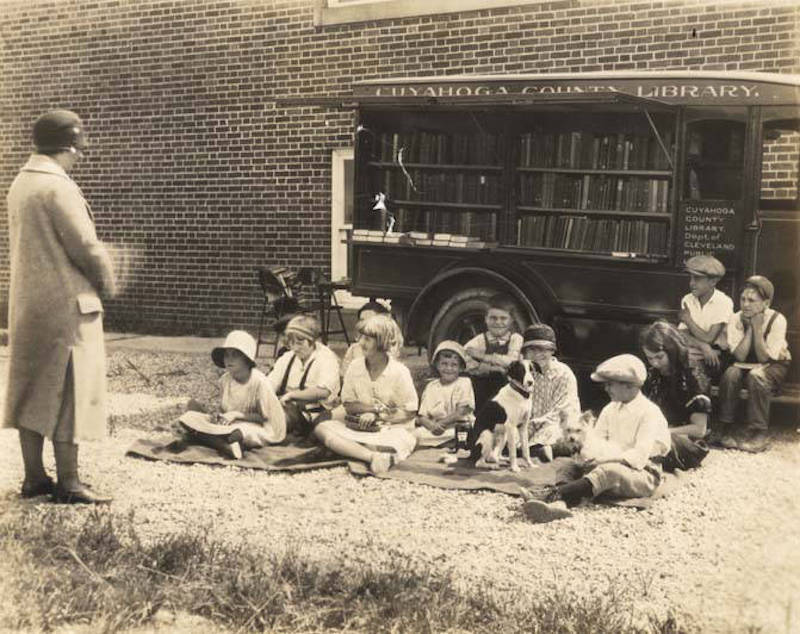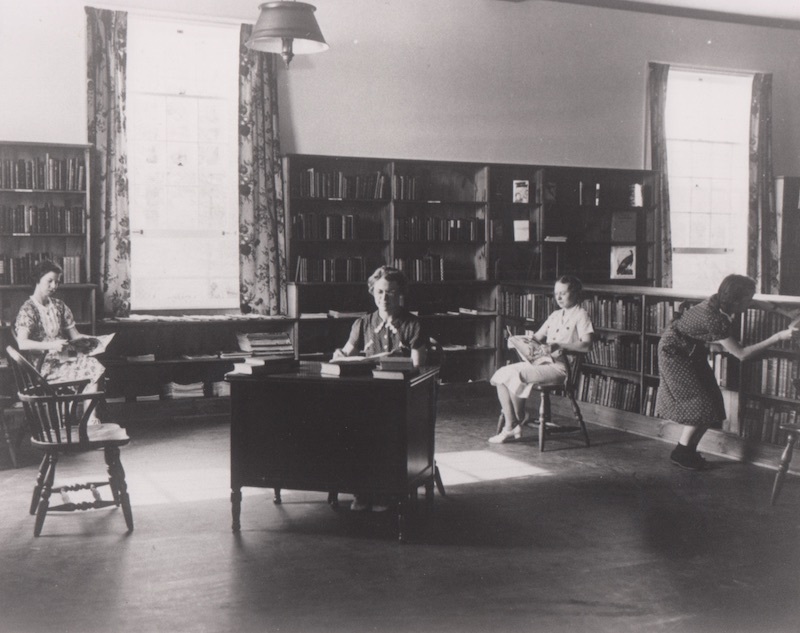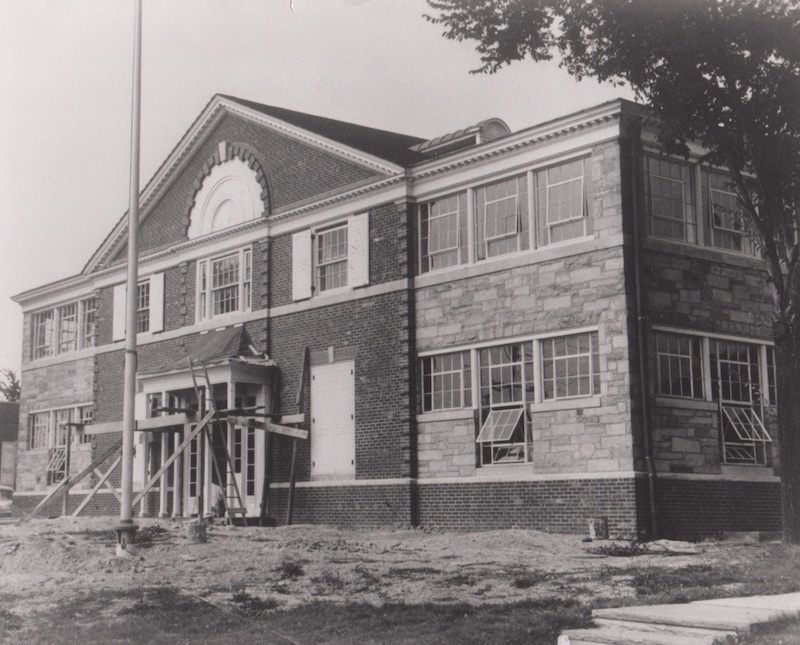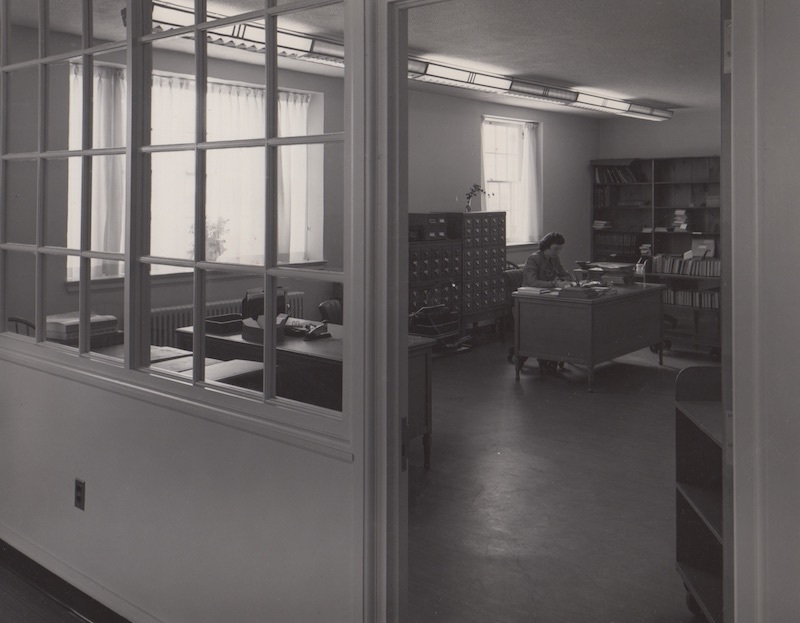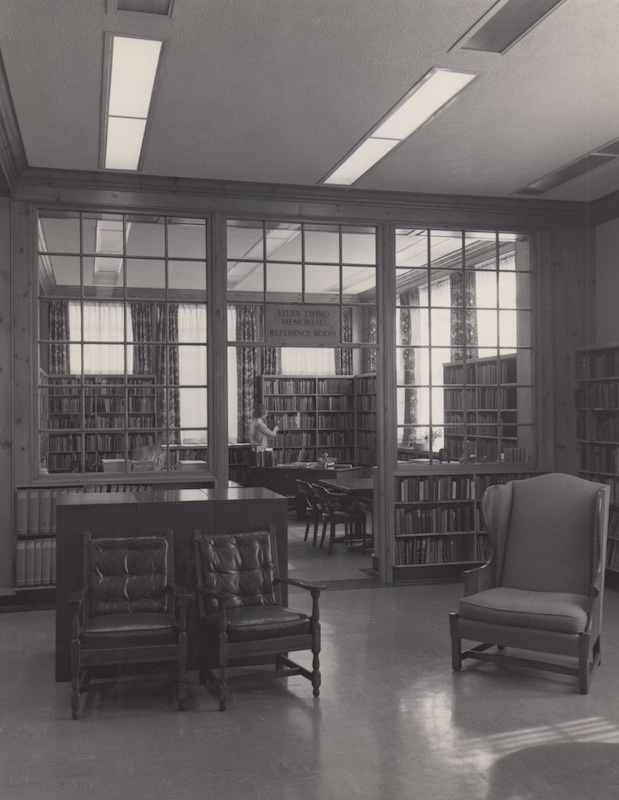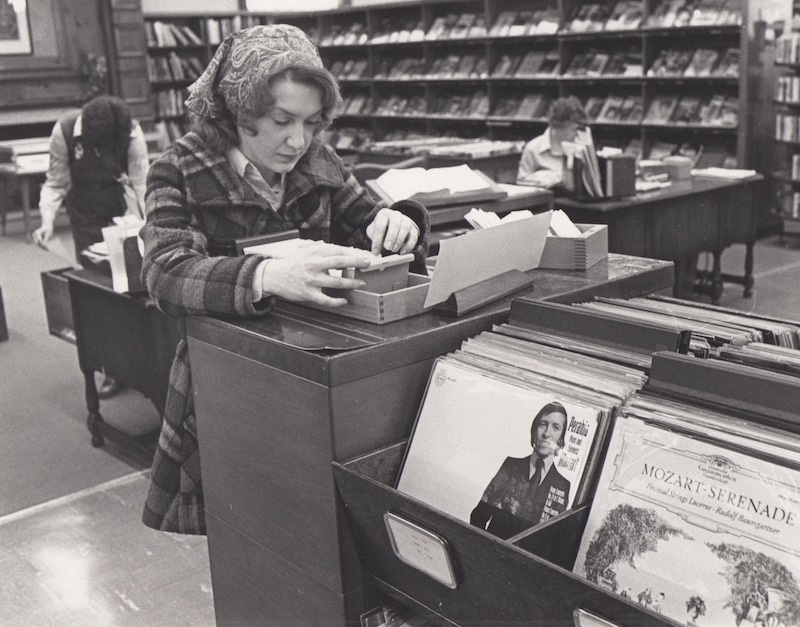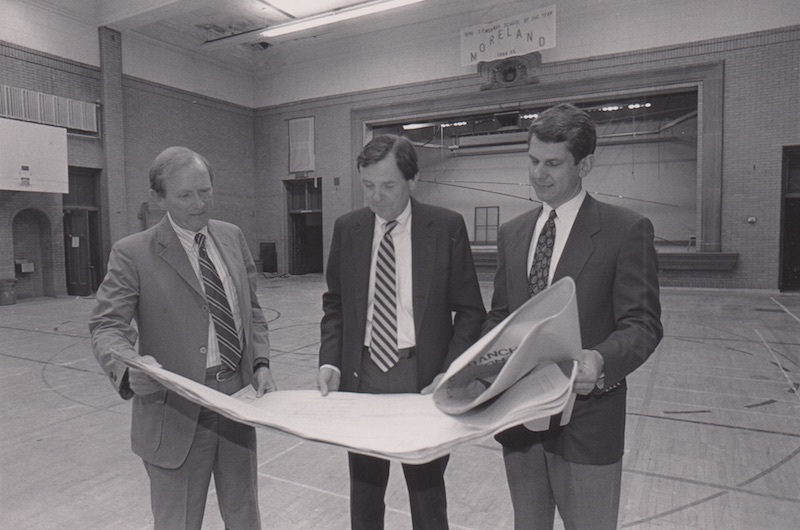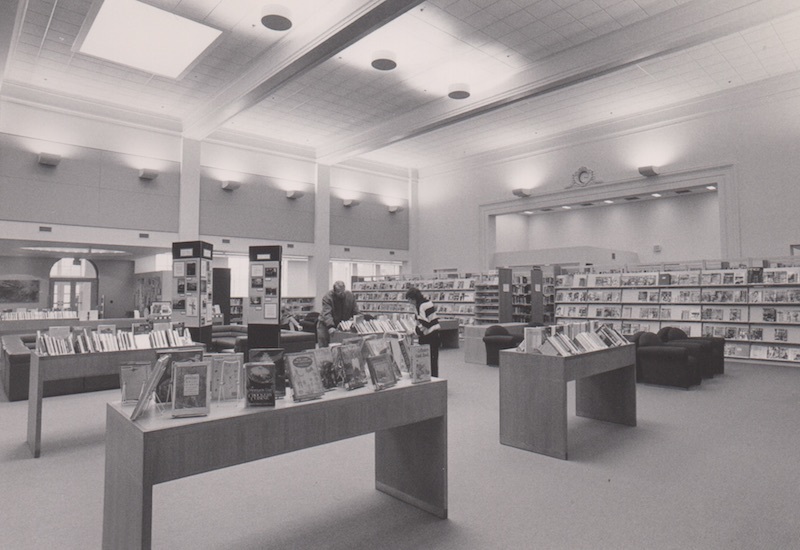Shaker Heights Public Library
A Legacy of the Van Sweringens' Shaker "Group Plan"

Public library services in Shaker Heights grew from within the walls of the village's school system. By mid-century, the library had emerged as a valued civic institution. Culminating in the opening of a stately structure on Lee Road in 1951, learn how these early years shaped the identity of Shaker Heights Public Library.
In 1913, a Van Sweringen “Group Plan” was beginning to take form in the young village of Shaker Heights. Construction of a stately school on Southington Road was nearing completion. Borrowing from the neighboring City of Cleveland’s ambitious efforts to centralize civic buildings, a large oval tract had been donated to the village by the Van Sweringens as a potential site for an elementary school, town hall, high school and small library. While Boulevard School would be the only structure realized at this site, the short-lived plan displays early efforts to anchor civic life around school buildings in Shaker Heights’ emerging residential community.
The Van Sweringen brothers invested heavily to bring this vision to fruition. A 1923 promotional publication for the Village of Shaker Heights claimed the investment of over two million dollars in property and equipment to the development of the village’s five educational institutions, and noted their intentions of building a school to serve each square mile of the suburb. By 1931, ten public schools had been constructed. Civic life centered around these educational institutions, which regularly housed the social, recreational, cultural and religious activities of the community. Despite the inclusion of a library in early plans for the Village of Shaker Heights, a public building devoted to this use was never erected during the suburb’s developmental years. Library services, however, grew from within the walls of Shaker Heights schools to become a valued public amenity. Prompted by community demand, an independent school district library was established in 1937 and the institution found a home in the Lee-Kinsman Building at the intersection of Kinsman (Chagrin Boulevard) and Lee Roads. By mid century, the library had emerged as a civic institution in its own right. These early years shaped both the future development and identity of Shaker Heights Public Library. The library’s significance as a civic institution and anchor of the Moreland neighborhood was reaffirmed in 1993 by a return to the place of its founding, the site of the former Moreland School.
Public library services in Shaker Heights grew from the dedicated study rooms and book collections of the village’s school libraries. The only Shaker Heights library recognized by the Library Club of Cleveland and Vicinity in its 1924 handbook was operated out of Shaker Heights High School. The school, which would later be renamed Woodbury Elementary School, established its library in 1919. A graduate of Western Reserve University Library School was appointed as librarian the following year. The library was available for use by teachers and students during the day. Its materials supplied Shaker Heights’ classrooms and school libraries. Transition from a school-based system into a public institution was prompted by the creation of the Cuyahoga County Public Library during the early 1920s.
Spearheaded by librarian Linda Eastman of the Cleveland Public Library, efforts to make the nationally renowned institution available to county residents were met with popular support. The Ohio State Legislature authorized the creation and funding of county libraries in 1921, and a regional vote approved the establishment of a Cuyahoga County district the following year. With the law to be enacted in April of 1924, Cleveland Public Library’s County Department was formed to begin making preparations for the extension of library services to all persons living within the county. Operated as a department of Cleveland Public Library, the County Library was an independent institution with its own personnel, book collection and funding. Early efforts focused on utilizing schools in outlying areas as distribution centers for library materials. The existing public libraries in Cleveland were also made available to county residents beginning in March, 1924.
Shortly after the creation of the County Department, negotiations began with Shaker Heights Superintendent of Schools to transform Shaker Heights High School Library into a branch of the new library system. The village’s Board of Education approved the plans in June, 1924, and services were made available to the public beginning in October of that year. A basement room at the high school was converted into a workspace for staff, and new shelving was added to the library. The existing book collection was supplemented by the County Library, and the position of school librarian taken over by a county employee.
The new librarian continued lending materials for classroom collections at Boulevard, East View, Malvern, Onaway and Sussex elementary schools, and immediately implemented in-house programming for Shaker Heights elementary school classes. To accommodate its new adult patrons, the library extended weekday hours till five in the afternoon and opened on Saturday mornings. Access to the library was briefly offered on Tuesday evenings, but little demand was found for the service.
During its first two years of operations at Shaker Heights High School, the County Library documented a steady rise in the circulation of materials. A 1926 report by the County Department noted that “the grown people of the community have discovered that the library is there and are demanding more service than our very new organization can give.” It was also quickly determined that the site of Shaker Heights High School was “far from ideal as a library center.” A new branch of the County Library was planned for Moreland School, which was under construction at the time. Shaker Heights Board of Education approved plans for a large room and workspace to be dedicated for use as a public library within the building.
The public library in Moreland School opened on November 2, 1926. Final plans for the site included a room for adults, a room for students, and a work space for staff. The new facility housed a mixed collection of books culled from both County Library resources and the Shaker Heights High School collection. Moreland School’s library immediately supplanted the High School as the center for elementary school book distribution and classroom visits, but the High School branch remained staffed by its county-funded librarian and housed administrative duties for patron registration. Demand for library services from both students and adults continued to grow, and the Board of Education approved the purchase of a book truck to facilitate transportation of incoming and outgoing requested materials.
Over the next decade, library services in Shaker Heights expanded as part of the Cuyahoga County Library system. Both Shaker Heights High School and Moreland School branches remained opened to the public, and furnished books to Shaker Heights’ Junior High and seven elementary school libraries. In response to community demand for increased services, including weekend and evening hours, the Shaker Heights Board of Education approved the creation of an independent school district library in 1937. A seven-member Library Board of Trustees was appointed by the Board of Education to govern the institution, which served the same geographic area as the school system. The Library Board was responsible for developing, implementing and overseeing all polices related to the library, including its services, budget and staff. The Cuyahoga County Library remained affiliated with the successor institution, allowing patrons to borrow from its circulating system. The independent library, however, operated separately from the Cuyahoga County branches and received a share of the intangible property tax revenue that financed the region’s libraries.
Arrangements were made to secure a site for the library at the intersection of Lee and Kinsman Roads soon after its institutional founding. The owner of the Lee-Kinsman Building would erect a 49- by 70-foot, one-story addition to his commercial structure, and the newly installed Library Board agreed to lease the building for five years. Additionally, the board hired Ellen Ewing as Head Librarian to oversee the process of organizing and purchasing books for the Shaker Heights community. Opened to the public in 1938, the leased storefront was only planned as temporary headquarters. In 1941, the Board of Education agreed to sell property on Moreland School grounds to the Library Board for the construction of a new library. East View School, which had served as the neighborhood’s elementary school prior to the opening of Moreland Elementary School, had been converted into warehouse space; It would be demolished to make room for the new structure. Bond issues were approved by Shaker Heights voters in 1945 and 1948 for library construction, but construction was delayed due to World War II.
Concerns over the legitimacy of the independent school district library also delayed construction plans. Beginning in 1946, the County Budget Commission reduced the income of several regional independent libraries. Interpreted as an attempt by the Cuyahoga County Library to absorb Shaker Heights’ library, the actions of the commission presented “an intolerable situation…that…will hamper the operation of the library in the coming year, jeopardize the proposed library building and deny the citizens of Shaker Heights the library services for which they have clearly expressed their desire.” The situation grew dire with the passage of a state law that barred the establishment of independent libraries in 1947. Because no prior law existed permitting Shaker Heights from withdrawing from the county system, the future of the library was in question.
In 1948, the Board of Education announced it would initiate a test case to determine the legal status of independent library systems. The sale of $150,000 in notes was ordered towards financing construction of the new Shaker Heights Library, which the Clerk-Treasurer refused to issue. The case went before the Cuyahoga County Court of Appeal, and was decided in the Board of Education’s favor. The Court of Appeals compelled the Clerk-Treasurer to sell Shaker Heights’ bonds, confirming the legality of independent libraries established prior to the 1947 state law. Bids were accepted by the Shaker Heights Library Board in 1949 for the construction of a new edifice at 3450 Lee Road, the current site of the Stephanie Tubbs Jones Community Building. The library’s construction was long overdue. More than 30,000 books were packed into the existing small, storefront location.
The new library opened to the public in 1951. Just as the head librarian curated materials for Shaker patrons, the state-of-the-art facility was fashioned to reflect the character of the community. The interior of the civic building exuded a comfortable, home-like setting. Elaborate woodwork, easy chairs, multicolored drapes, end tables, reading lamps and an open fireplace offered visitors the ambiance of a residential study. Upon entering a room devoted to the history of the Shaker religious community, peg board floors and an off-white paint job presented patrons with a historically accurate replication of the religious sect's penchant for the austere. Low tables marked areas devoted for use by children, while space for quiet study acted as a memorial to the recently deceased Ellen Ewing.
Over the next four decades, the independent library continued to expand and diversify its services. Building renovations were made, the Bertam Wood branch opened and a number of outreach programs were instituted. Computer terminals replaced card catalogs, while patron access to library materials grew exponentially with the introduction of the Online Computer Library Catalog database and CLEVNET. The introduction of videocassettes, books-on-tape and audio compact discs to the library catalog precipitated a surge in circulation beginning in the late 1980s.
Sources of revenue to finance library services also changed. Beginning in 1974, county funds were supplemented through the passage of local library tax levies. Shaker Heights residents regularly displayed support for their independent library through the passage of operational levies since that time. Per capita circulation of Shaker Heights Public Library materials consistently remained the highest in the county during the 1980s and 1990s.
As the once-spacious building at 3450 Lee Road grew crowded with materials and patrons, plans were developed to expand and modernize the main library. After exhaustive studies, the recently vacated Moreland School site next door was chosen as the library’s new home. Previously relegated to rooms at the eastern entrance of the structure between 1926 and 1938, the library would return to Moreland School as the primary occupant. The school house would once again be an anchor for civic life in the region. The new library was dedicated and opened to the public in 1993.
Images

